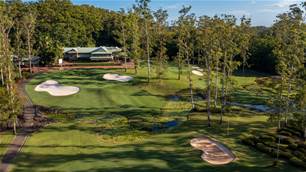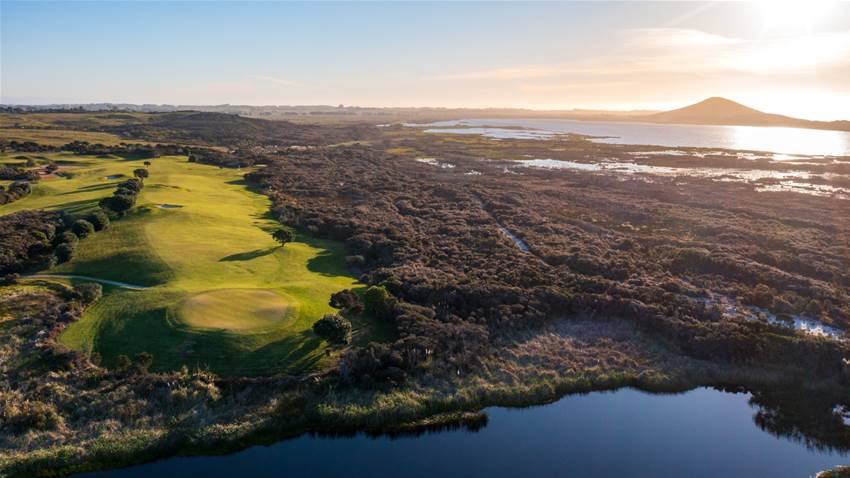The seaside location of the Carrington Estate had me fully expecting to find a links style course.
But this stunning layout on the Karikari Peninsula – about five hours’ drive north of Auckland Airport – might lie near (not quite beside) the Pacific Ocean but it is surprisingly more like an inland course with large naturally occurring water hazards and a rolling landscape dictating the flow of holes.
Carrington was developed by American billionaire investment banker Paul Kelly back in the 1990s. Kelly purchased a large swath of coastal land across the top of the North Island. This included 3,000 acres on the Karikari Peninsula which he developed into the then named Carrington Club golf course, luxury lodge and the neighbouring Karikari Estate vineyards, New Zealand’s northernmost winery which has won gold medals in world competitions. The property also incorporates four spectacular kilometres of secluded white sand coastline but it also is home to a herd of acclaimed Black Angus beef cattle which grazes on the more gentler rolling pastures west and east of the course.
In 2002, Kelly enlisted American course architect Matt Dye to rebuild that layout which remains New Zealand’s northernmost resort golf course. The remodelled course reopened for play in December 2003. A decade later, Kelly sold the resort to Shanghai Cred, a Chinese company owned by billionaire Gui Guojie, for NZ$28 million.
The name Dye might sound familiar. Matt is a third-generation member of the world-acclaimed Dye family of golf course designers, having followed the family tradition established by grandfather Paul, his late father Roy and his uncle and aunty, Pete and Alice Dye.
He started in golf course design in 1989 working with his cousin – Perry Dye of Dye Designs – designing, shaping and building courses all over the world. He worked on designs in Japan, Thailand and Mexico as well as numerous U.S layouts including Trump National Golf Club in Los Angeles.
Matt began his own design business in 2002 and Carrington was his first solo project. He received plenty of accolades for his work at Carrington, which led to more work in the U.S but sadly he passed away just five years after his maiden creation was unveiled.
Dye’s course lies on beautiful, interesting land, where the views, especially from the clubhouse and lodge, towards the 15-metre-high sand dunes backing Karikari Beach and Rangaunu Bay, are breathtaking. Adding to the visual pleasure are the naturally occurring wetlands and amazing bushland that lies between the beach and the course.

The natural contours of the land and the length of the layout – stretched to a 6,633-metre, par-72, from the ‘Tiger’ tees – combine to create a stern challenge for better players. Thankfully there are four other teeing options that present a less demanding layout length.
While the length can be considered demanding, especially on windy days of which there are many, it is some of Carrington’s short holes that will really impress and are a credit to Dye’s inspired use of the landscape.
The first fine example of this can be found midway through the front nine. As you step onto the back tee of the 301-metre par-4 5th it is not immediately obvious exactly where your best route to the hole might be. The fairway not only cascades dramatically down from tee to green, but it also doglegs 45 degrees from right to left, following the plateau that sits above scrub and wetlands to the left. Depending on the wind direction, you can hit a range of clubs to reach a steep downhill section of the fairway. The real test here comes with the second shot which will be played from a downhill lie into a narrow but deep green, protected by a large bunker scheme short right and features wetland scrub left and through the back. A low trajectory approach shot can easily bound through into a horrible lie that will be difficult to recover from.

The two holes that follow are as equally testing, as much for their visual intimidation as the shots they demand. The 6th is a 350-metre par-4 where the pressure is on the drive as the tee shot must be played across a wetland to the fairway that lies at an oblique angle to the direction of your shot. And it is a narrow landing area wedged between impenetrable scrub to the right and wetlands left. There is no room for heroics here, just hit the fairway, then the smallish kidney-shaped green and move on. Despite measuring 75 metres shorter than the longest par-4 on the layout, this tight hole understandably still rates as Carrington’s hardest.
At the following hole, the tee shot must carry the entire width of the wetlands –home to dotterals, black swan, kingfishers as well as grey and mallard ducks – and lake to reach the green, which is two thirds surrounded by water. From the shortest tee it is a wee pitch of just 55 metres but from the back tees a solid blow is needed from 165 metres to safely find the putting surface.
The back nine is simply breathtaking with water views across to Mt Puheke being a constant. There are fewer trees – although the native Pohutukawa tree is a regular feature – and there’s a little less wild scrub beside the fairways but Dye has punctuated each hole, between tee and green, with creative bunkering and the original creeks and water courses uncovered during construction.

There are some impressive driving holes on the inward nine, with the first of them being the 418-metre par-4 12th, which plays along the edge of thick seaside scrub that separates the course from Karikari Beach and Rangaunu Bay. It’s a straight hole but the fairway features a right-to-left for most of the trek between tee and green, which can see drives bound towards the left rough, and scrub, if your ball starts moving in that direction in the air. The green is a small bunkerless target with a steep drop-off right around the back and right edge, which can propel overhit approaches into the scrub.
Carrington is home to the longest par-5 in New Zealand with the 14th that stretches to 605 metres but plays even longer as the trek, and it is a trek, is all uphill from the lowest corner of the course to arguably one of the highest greens on the layout.

One of the standout holes on the journey back to the clubhouse is the 403-metre par-4 15th. This is a fantastic driving hole where the longest and straightest drives are well rewarded with a relatively easy approach the green. The key here is to pick a driving line, which will successfully carry a deep gully that extends the length of the left side of the dogleg left fairway. The best, and shortest, approach to the green is from the left half of the fairway so the player who risks all to clear the gully will certainly be rewarded.
In the 20 years since Dye finished his rebuild at Carrington, the design has always been highly acclaimed by pundits. The presentation of its playing surfaces has been more inconsistent though, particularly during the past decade. The floods and high rainfall associated with Cyclone Gabrielle that hit New Zealand’s North Island almost 12 months ago, took its toll on the Carrington course but it was showing definite signs of recovery during my visit for this review.
FACT FILE
LOCATION: Matai Bay Rd, Karikari Peninsula, Northland, New Zealand.
CONTACT: +64 (09) 408 7222.
WEBSITE: www.carrington.co.nz
DESIGNER: Matt Dye (2003).
PLAYING SURFACES: Brown Top bentgrass (greens), kikuyu (fairways).
GREEN FEE: NZ$180 (18 holes), NZ$90 for repeat rounds during visit.
ACCOMMODATION: Carrington Estate has 10 spacious lodge rooms and 13 three-bedroom villas, which feature views of the course, vineyards and the Pacific Ocean.
Lodge Rooms, located in the heart of the Estate, are connected to wide verandahs that lead to the resort’s superb restaurant, guest lounge and other facilities.
Related Articles

Course Review: Cape Kidnappers

Review: Bonville Golf Resort













